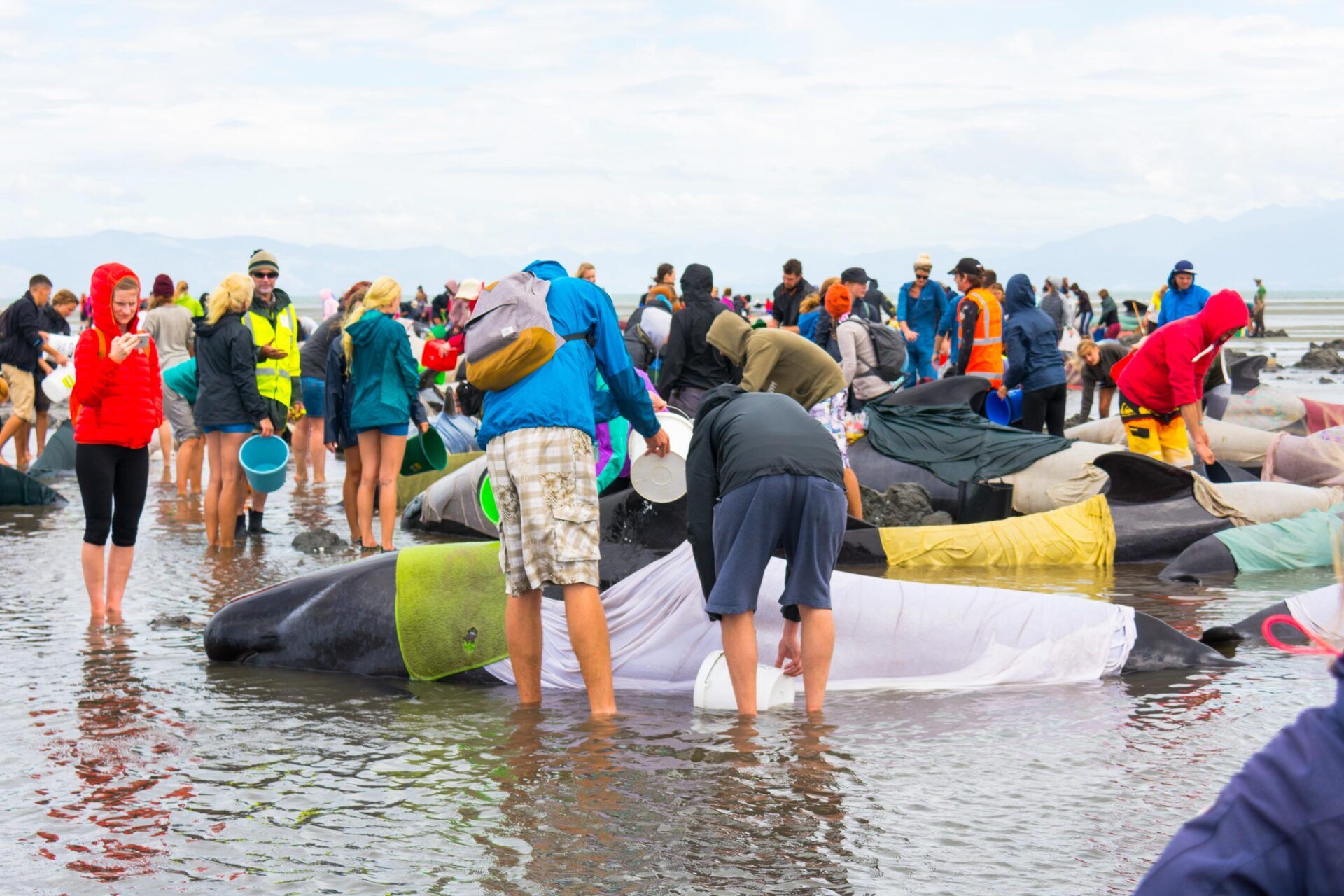New Zealand’s waters are awash with cetaceans. But sadly, while almost half of the world’s dolphin, whale and porpoise species call New Zealand’s waters home or visit here during their annual migration, every year some tragically end up stranded on our beaches requiring help to return to the ocean.
New Zealand is one of the world’s hot spots for marine mammal strandings with more than 5,000 strandings of whales and dolphins recorded around the coast since 1840. Two of the world’s largest ever recorded strandings have happened on our shores, including tales of more than 1,000 pilot whales washed ashore on Long Beach on the west side of Chatham Island in 1918, while about 600 pilot whales stranded at Farewell Spit in 2017.
Though Canterbury is not a hot spot like Farewell Spit, Northland, Hawke’s Bay or the Chatham Islands, the region has had its fair share of strandings. Between 1846 and 2015 the Department of Conservation has recorded more than 350 whale and dolphin strandings in the region, with the 2010 stranding of around 60 pilot whales in Port Levy the biggest.
Last June (2020), Timaru hit the headlines when a giant sperm whale stranded in Caroline Bay. The mere sight of a 14-metre-long sperm whale weighing between 10 and 20 tonnes lying 50 metres from shore garnered people’s attention, with hundreds gathering to watch the tragedy unfold.
A huge rescue effort ensued with members from the Department of Conservation, PrimePort Timaru, Coastguard and volunteers from Project Jonah working tirelessly to refloat the colossal creature back to sea. After other measures were unsuccessful, diggers were brought in at low tide to create a channel between the ocean and the whale before the tide returned. As the tide came in, and with the help of a fishing vessel from PrimePort, the whale managed to get free, swimming under its own power for deeper water.
‘It was the best possible outcome,’ says Daren Grover, General Manager of Project Jonah. ‘Sperm whales usually live in deep areas of the ocean, so it’s very rare to see one close to shore. For many it was a once-in-a-lifetime opportunity to see such an incredible animal. It’s also only the third time that a sperm whale has been successfully refloated in New Zealand.’
Sadly, a beached whale or dolphin is an all too familiar sight on New Zealand beaches due to our geographic location and unique marine environment. This is even more common especially during the summer months, as more animals are swimming closer to our shores, Daren says.
On average about 300 whales and dolphins become trapped on our shores annually. While it’s mostly individuals that strand – the most common species being the pygmy sperm whale, common dolphins and beaked whales – when it comes to mass strandings, no species strands as often as the long-finned pilot whale. Though much is known about these gentle mammals, reasons why whales strand has puzzled scientists for centuries.
Evolving over the past 50 million years, whales are the largest mammal ever to have graced planet earth. Fossil records show that the earliest whales lived on land, walked on four legs and foraged in rivers and estuaries for fish. Around 40 million years ago, the first fully aquatic whales appeared.
Whales can be divided into two families – Odontoceti (toothed whales) and the filter-feeding Mysticeti (baleen whales). Toothed whales, such as sperm whales, pilot whales and dolphins, are the most species-rich group with more than 70 different species found from the cold Antarctic waters to warm tropical ones. They include dolphins and porpoises, as well as the larger beaked and sperm whales, and a number of river dolphins. They have teeth (though these may not always be obvious) and use echolocation to navigate and hunt for fish and squid.
In comparison, baleen whales have plates of baleen suspended from the roof of their mouths, through which enormous quantities of krill are filtered from the water. Baleen whales are generally larger than toothed whales, they include the largest whale of all, the blue whale, as well as humpback and southern right whales.
Like humans and other land mammals, they have three inner ear bones and hair, they breathe air, and females produce milk through their mammary glands and suckle their young. They also have long gestation periods, typically ranging from 10 to 17 months, and are long-lived with most toothed whales living between 20 and 60 years. Bowhead whales live up to an incredible 200 years, while fin whales are known to live for at least 100 years.
Whales and dolphins, for the most part, are very social creatures, able to recognise one another, coordinate group activities and maintain contact over long distances, thanks to their complex system of communication.
Despite decades of research, scientists are no closer to explaining why mass strandings occur. ‘They [solitary mammals] usually strand for a reason, but it’s often a combination of factors,’ says Daren.
Scientists have narrowed it down to around 14 reasons as to why they occur, ranging from being old, sick or injured, to navigational errors, and hunting too close to shore. Bad weather can also play a part. In the case of pilot whales, there are many theories, but it’s widely accepted that their strong social bonds call the rest of the pod to help when one gets in trouble. Though whale and dolphin strandings can’t be prevented, knowing what to do when they do happen can make all the difference to the outcome, Daren explains.
Whale strandings are managed by the Department of Conservation, but local community members and organisations such as Project Jonah play an integral part in saving whales.
Born out of the ‘save the whales’ movement of the 1970s, Project Jonah’s focus has grown from an anti-whaling lobby group to animal welfare, assisting in whale strandings up and down the country while continuing to raise awareness.
For more than 30 years, they have been actively involved in education, offering one-day whale saving workshops for the general public. During that time they have trained more than 4,500 volunteer Marine Mammal Medics nationwide, but Daren says more are still needed. Their aim is to train at least 400 a year.
Marine Mammal Medics not only learn how to help stranded whales and dolphins, but also how best to look after themselves and avoid the risks, while helping others do the same. Some strandings last for days at a time, often in isolated places, so it’s important people have enough appropriate clothing, high energy food, fresh water and sunblock, says Daren.
While there’s no shortage of people willing to help, he says saving whales isn’t as easy as it looks, and if you don’t know what you are doing you can cause more harm than good. ‘Sometimes people try to get the whales back in the water as quickly as possible by dragging the tail. This could mortally injure or even drown a whale or dolphin. It’s really sad. If they’re injured and cannot swim, they are completely helpless. They don’t know if they are going to live. It’s an incredibly stressful time for the animal. Our work is to remove as many points of stress [as possible],’ Daren explains.
The most important thing to do is try to keep the whales cool, calm and comfortable. Overheating is the biggest risk factor due to their dark skin and a thick layer of blubber beneath, but they can be kept cool with light-coloured towels or sheets, carefully arranged to leave the fins, eyes and blowhole exposed. Buckets of water should be gently tipped over them, avoiding the blowhole. Avoid making sudden, loud noises and don’t stand or sit directly in front of their heads.
Despite the efforts of rescuers and advancements in rescue techniques, not all strandings end in triumph. Tough decisions often have to be made as to whether to euthanise a whale. In some cases, it’s more humane to end their suffering.
Over the past nine years with Project Jonah, Daren has experienced it all. ‘I’ve been through the highs and the lows. You don’t ever forget, but you can’t let the emotion override you. At the end of the day, their welfare is paramount in all that we do,’ he says.
For those interested in becoming a Marine Mammal Medic, courses are routinely held in Christchurch and Kaikōura. Refresher courses for those already qualified are also available.
WHO TO CALL
Members of the public who stumble across a marine mammal in distress can call:
PROJECT JONAH’S 24-HOUR HOTLINE
on 0800 4 WHALE (0800 4 94253)
DOC’S HOTLINE
on 0800 DOC HOT (0800 362 468)
Project Jonah advises that if all else fails, people can call 111 and inform police.
Recent stories



All Rights Reserved | CountryWide Media




